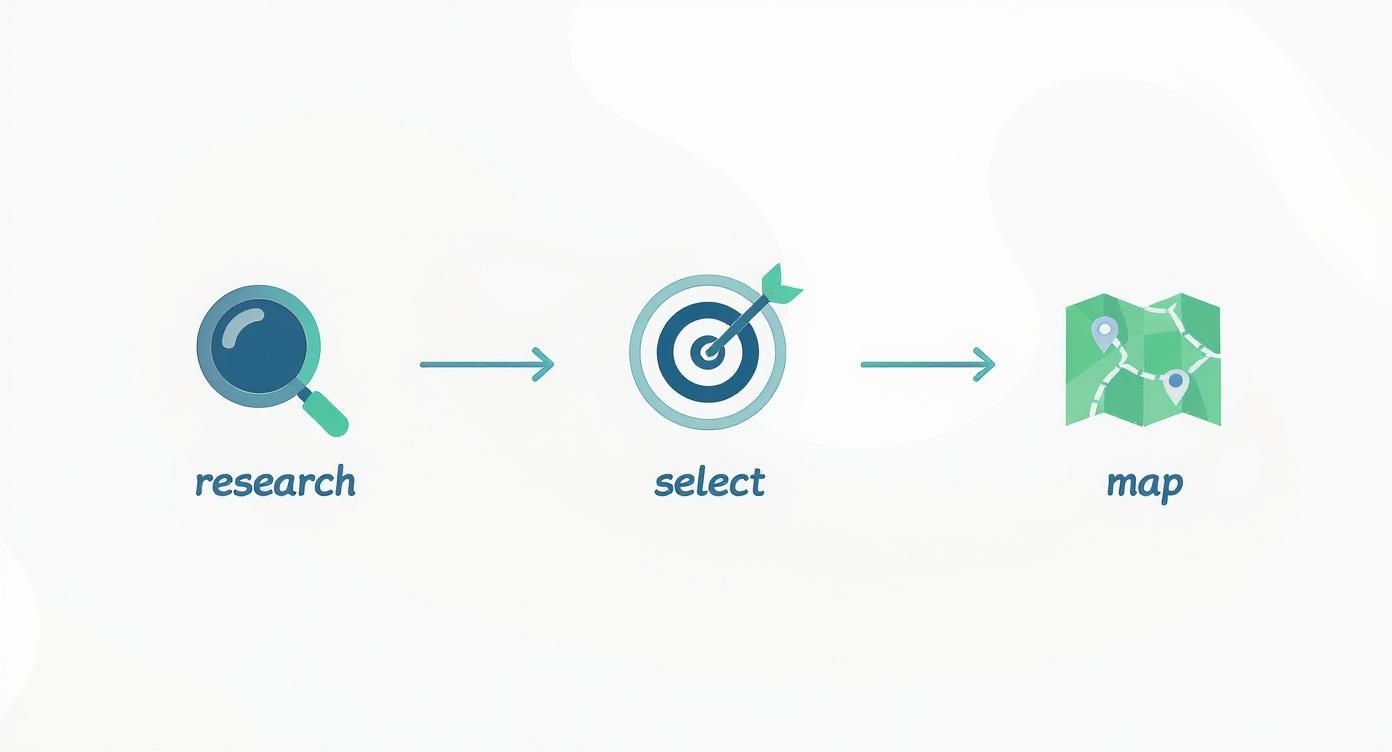
Meta Description: Still asking "how many keywords per page"? Learn the modern SEO strategy: focus on one primary keyword and 2-3 secondary terms to build topical authority.
Trying to figure out exactly how many keywords to target per page can feel like an impossible puzzle. You've heard that "keyword stuffing" is a huge mistake, but you also know that without the right keywords, your content will never be found. It’s a common challenge for marketers and creators alike: how do you optimize for search engines without sounding like a robot?
The good news is that the answer has become much clearer. The old method of cramming in as many keywords as possible is dead. Today, the winning strategy is to target one primary keyword and up to three secondary keywords per page. This modern approach helps you create focused, high-value content that both Google and your audience will love.
From Keyword Quantity to Topic Quality
For years, the SEO world obsessed over a simple question: "How many keywords should I put on my page?" This led to the dreaded practice of "keyword stuffing"—jamming the same phrase into a post over and over. That tactic doesn't just fail today; it actively harms your rankings. Modern search engines are far too sophisticated for such simple tricks.
They’ve shifted from counting keywords to understanding topics. The new game is about quality and relevance, not just quantity. Think of it like this:
- Your primary keyword is the central theme of your article.
- Your secondary and long-tail keywords are the supporting details that provide context and depth.
By focusing on a single core topic and supporting it with related subtopics, you build what’s known as topical authority—a massive signal to search engines that you are an expert. Instead of creating a dozen thin pages for minor keyword variations, you create one powerhouse resource that ranks for its main keyword and hundreds of related terms.
This strategy delivers real results for content creators and marketers:
- A Better User Experience: Visitors find a complete answer in one place, keeping them engaged and signaling value to Google.
- Clearer Signals to Search Engines: A tightly focused page makes it easy for Google to understand what your content is about.
- Higher Ranking Potential: Comprehensive, authoritative content is far more likely to rank for its primary keyword and its many variations.
While the old obsession with keyword density is fading, most 2025 SEO guides suggest that this approach naturally lands you in the healthy 0.5% to 2% keyword density range. To really master this, it's worth digging into the necessity of keyword research to stay ahead.

Choosing Your Primary and Secondary Keywords
Now for the practical part. How do you select the right mix of keywords to create a powerhouse piece of content? The key is to match your content's purpose with what real people are typing into Google.
Think of your primary keyword as the headliner for a concert—it’s the main draw. It should be specific enough to capture user intent but broad enough to have solid search volume. For a marketing agency, a strong primary keyword might be "AI content creation tools."
Your secondary keywords are the opening acts. They add depth and address related subtopics, like "best AI text generator for blogs" or "using AI for marketing visuals." These terms help you capture a wider audience with slightly different needs, all within the same article.
Here’s a simple process for any creator or marketer to follow:
- Identify the Core Problem: What pain point does your audience have? Start with a broad "seed" topic, like "social media automation."
- Find Your Primary Keyword: Use a keyword research tool to find a high-intent primary keyword with good search volume, such as "AI social media scheduler."
- Select Secondary Keywords: Look for long-tail variations and related questions people are asking. For example, "best AI post scheduler for Instagram" or "how to automate content creation."
- Integrate Naturally: Weave these keywords into your headings, introduction, and body content. The goal is to sound helpful, not robotic. If this feels tricky, our guide on copywriting tips for beginners can help.
Using a tool like Google Keyword Planner helps you find that sweet spot between search volume and achievable competition. For a deeper dive, this guide on how to choose keywords for SEO is an excellent resource.
How to Build Topical Authority with Semantic SEO
Great SEO today is less about "how many keywords per page" and more about mastering an entire topic. This is the concept of topical authority, and it's what search engines reward most. Instead of just targeting keywords, your goal is to demonstrate a deep understanding of a subject.
For example, an authoritative article on "email marketing automation" should naturally cover related concepts like "subscriber segmentation," "A/B testing subject lines," and "improving email deliverability." This is Semantic SEO: focusing on the meaning and context behind search queries, not just the exact words. Modern search algorithms understand synonyms and related ideas, rewarding content that covers a topic comprehensively.
Here’s how you can build topical authority in your content:
- Mind Map Your Topic: Before writing, brainstorm every related subtopic and question. Think about the entire journey your reader is on.
- Analyze the Competition: Look at what top-ranking pages cover. Your goal is to find the gaps they missed and create a more complete resource.
- Use LSI Keywords: Sprinkle in Latent Semantic Indexing (LSI) keywords—thematically related terms that add context and help search engines understand the nuances of your topic.
This approach proves your expertise to both readers and search engines. To see these principles applied in a technical field, check out our post with machine learning code examples.

When you focus on creating a comprehensive resource, you stop playing the keyword-counting game and start creating value—which delivers SEO results that last. You can explore more data on modern keyword metrics to see just how much the game has changed.
Real-World Examples of Keyword Strategy
Theory is great, but let's see how this tiered keyword strategy works in practice for different types of content creators and marketers.
Use Case 1: The Marketing Agency Blog Post
A digital agency wants to attract clients interested in AI. Their goal is to create a comprehensive guide that showcases their expertise.
- Primary Keyword: "ai content creation tools". This targets users actively looking for software recommendations.
- Secondary Keywords: "best ai text generator," "ai image creation for marketing," and "using ai for social media content." These become H2s that address specific use cases.
- Long-Tail Keywords: "how to choose an ai content tool," "free ai tools for small business." These are perfect for H3 subheadings or an FAQ section.
Use Case 2: The SaaS Company Product Page
A SaaS company like MediaWorkbench.ai is promoting its AI-powered content scheduling feature. The page needs to convert visitors.
- Primary Keyword: "ai social media scheduler." A high-intent keyword for users ready to find a solution.
- Secondary Keywords: "automate instagram posts," "ai content calendar," and "smart post scheduling tool." These highlight specific features and benefits.
- Long-Tail Keywords: "how does an ai scheduler work," "ai social media scheduler for agencies." These answer common questions and build trust.
Use Case 3: The Solo Creator’s How-To Guide
A freelancer is writing an in-depth guide on their blog to build authority and attract an audience.
- Primary Keyword: "seo for blog posts." A broad, informational keyword targeting beginners.
- Secondary Keywords: "on-page seo checklist," "how to write seo-friendly content," and "keyword research for blogs." These break the topic into actionable steps.
- Long-Tail Keywords: "where to put keywords in a blog post," "simple seo tips for beginners." These ultra-specific questions attract highly engaged readers.
By adopting this tiered approach, you build pages that are structurally sound and topically complete. To dive deeper into crafting compelling content, check out our guide on SEO copywriting tips.
👉 Try MediaWorkbench.ai for free – schedule your posts and generate AI content in one place!
Conclusion: A Modern Path to Keyword Success

The answer to "how many keywords per page" has evolved. Instead of chasing a specific number, modern SEO success comes from focusing on a single primary keyword and supporting it with 2-3 secondary keywords. This strategic approach helps you build topical authority, create a better user experience, and earn higher rankings that last. By prioritizing quality over quantity, you create content that genuinely serves your audience and satisfies search engines at the same time.
Ready to put this strategy into action? MediaWorkbench.ai helps you discover the right keywords and generate high-quality, SEO-friendly content in minutes. Stop guessing and start creating content that drives results.

